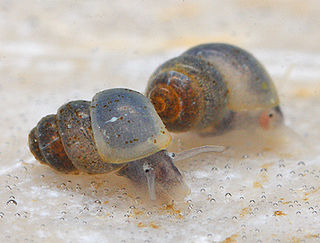
Caucasotachea vindobonensis is a large species of air-breathing land snail, a terrestrial pulmonate gastropod in the family Helicidae.

Bithynia tentaculata, common names the mud bithynia or common bithynia, or faucet snail is a relatively small species of freshwater snail with gills and an operculum, an aquatic prosobranch gastropod mollusk in the family Bithyniidae.

Physella acuta is a species of small, left-handed or sinistral, air-breathing freshwater snail, an aquatic gastropod mollusk in the family Physidae. Common names include European physa, tadpole snail, bladder snail, and acute bladder snail. In addition, Physa acuta, Physa heterostropha and Physa integra are synonyms of Physella acuta.

Viviparus contectus, common name Lister's river snail, is a species of large, freshwater snail with an operculum and a gill, an aquatic gastropod mollusk in the family Viviparidae, the river snails.

Theodoxus danubialis is a species of small freshwater snail with an operculum, an aquatic gastropod mollusk in the family Neritidae, the nerites. The species is considered as endangered in Germany, Austria and in the Czech Republic.
The striped nerite, scientific name Theodoxus transversalis, is a species of small freshwater snail with an operculum, an aquatic gastropod mollusk in the family Neritidae, the nerites.

Theodoxus fluviatilis, common name the river nerite, is a species of small freshwater and brackish water snail with a gill and an operculum, an aquatic gastropod mollusk in the family Neritidae, the nerites.

Anisus spirorbis is a species of small freshwater air-breathing snail, an aquatic pulmonate gastropod mollusk in the family Planorbidae, the ram's horn snails.

Bithynia leachii is species of small freshwater snail with an operculum, an aquatic prosobranch gastropod mollusk in the family Bithyniidae.

Bythinella pannonica is a species of small freshwater snail with an operculum, an aquatic gastropod mollusk in the family Hydrobiidae.

Viviparus acerosus is a species of freshwater snail with an operculum, an aquatic gastropod mollusk in the family Viviparidae, the river snails.

Bythinella austriaca is a species of very small freshwater snail with an operculum, an aquatic gastropod mollusk in the family Amnicolidae.

Alzoniella slovenica is a species of very small or minute freshwater snail with an operculum, an aquatic gastropod mollusk in the family Hydrobiidae, which are sometimes known as the snouted water snails.

Lithoglyphus is a genus of freshwater snails with gills and an operculum, a gastropod mollusk in the family Lithoglyphidae.
Nicolla skrjabini is a species of trematodes in the family Opecoelidae.

















